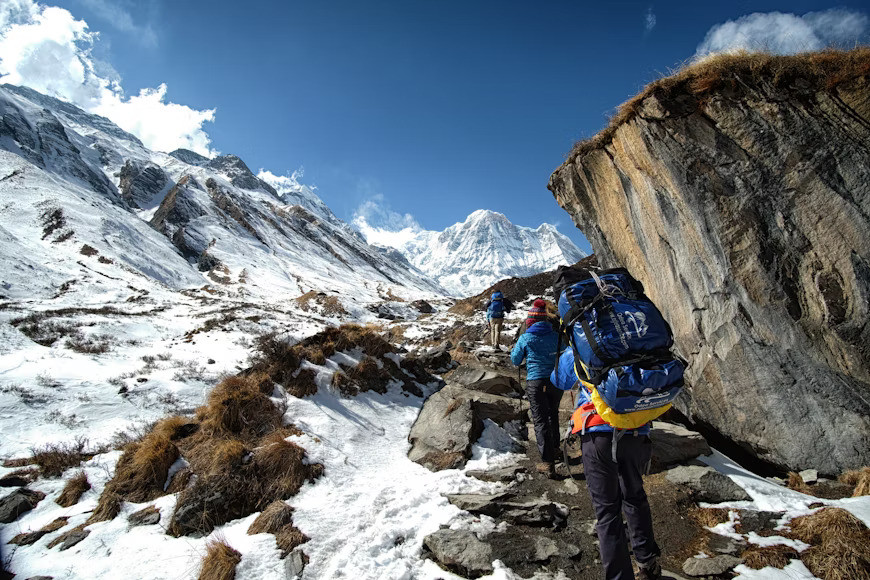The Annapurna Base Camp Trek is one of Nepal’s most iconic and rewarding trekking experiences, blending breathtaking mountain scenery with rich cultural encounters. It takes you deep into the heart of the Annapurna region, leading you to the foot of some of the world’s tallest and most majestic peaks, including Annapurna I, Machhapuchhre (Fishtail), Hiunchuli, and Annapurna South.
This journey typically begins in the bustling lakeside city of Pokhara, where the tranquil Phewa Lake reflects the snowcapped mountains in the distance. From there, the trail winds through a variety of landscapes, from terraced farmland and bamboo groves to dense rhododendron forests and alpine meadows. Along the way, you’ll pass through charming villages like Chhomrong, Bamboo, and Deurali, where you’ll get to experience the warmth and hospitality of the local Gurung and Magar communities.
Each day of the trek brings a new view, a new rhythm, and a deeper sense of connection to the natural surroundings. You’ll be walking alongside rivers, crossing suspension bridges, and gradually gaining altitude as the peaks rise higher and closer with every step. The trek is considered moderate in difficulty, with some steep ascents and descents, but it’s manageable for anyone with a reasonable level of fitness and determination.
The ultimate highlight of the journey is reaching Annapurna Base Camp itself, nestled at an altitude of around 4130 meters. Standing in this natural amphitheater, surrounded on all sides by towering mountains, is an awe-inspiring moment that many trekkers describe as spiritual. It’s a place where silence, snow, and sky meet—and where every effort to reach it feels worthwhile.
Throughout the trek, you’ll stay in simple but welcoming teahouses, where fellow trekkers gather around warm stoves to share stories over plates of dal bhat and cups of ginger tea. The route is well-established and safe, and the infrastructure along the trail makes it one of the more comfortable treks in Nepal.
Whether you’re seeking stunning Himalayan vistas, a cultural adventure, or simply a break from the modern world, the Annapurna Base Camp Trek offers a perfect blend of all three. It’s not just about reaching a destination—it's about experiencing the journey through some of the most beautiful terrain Nepal has to offer.


Maximum altitude reached is 4,130 meters at Annapurna Base Camp. While this is high enough for mild altitude symptoms, the risk of serious altitude sickness is low due to the steady ascent and proper acclimatization.
This trek is considered moderate to challenging. It involves daily hikes of five to seven hours with a mix of ascents, descents, and stone steps.
Weather can change quickly in the mountains, so you should be prepared for both warm days and chilly nights, especially above 3,000 meters.
The best seasons to do this trek are spring (March to May) and autumn (September to November), when the skies are clear and mountain views are at their best. Winter is possible but cold. Monsoon (June to August) is not ideal due to rain and leeches.
Hydration and pacing are key to avoiding altitude-related issues. Drink plenty of water and walk at a steady pace, especially on the ascent to base camp.
Always carry travel insurance that includes coverage for trekking up to at least 4,500 meters and emergency evacuation by helicopter.
Respect local culture and customs, especially in mountain villages and religious sites. A simple greeting of “Namaste” and modest clothing go a long way.
Your journey begins with your arrival in Kathmandu, the capital of Nepal. A representative will greet you at the airport and transfer you to your hotel. This day is mostly for rest and recovery after your flight. If time permits, you can explore the vibrant streets of Thamel, grab a traditional Nepali meal, or prepare for the adventure ahead.

Hotel/Lodge

Breakfast/Lunch/Dinner
After breakfast, you set out on a scenic drive to Pokhara, Nepal’s picturesque lakeside city. The drive takes around six hours and offers views of terraced fields, river valleys, and rolling hills. Upon reaching Pokhara, you’ll check into your hotel and have time to relax or take a peaceful walk along Phewa Lake.

Hotel/Lodge

Breakfast/Lunch/Dinner
In the morning, a short drive takes you to Sibai, a small village that serves as your trek starting point. From there, you begin your hike through forested hills and scattered settlements. The trail gradually ascends toward Chhomrong, a beautiful Gurung village perched on a ridge with stunning views of Annapurna South and Hiunchuli. The day’s trek takes about six to seven hours including breaks.

Hotel/Lodge

Breakfast/Lunch/Dinner
Today you descend to the Chhomrong Khola and cross a suspension bridge before climbing again through dense forests of bamboo and rhododendron. The trail is peaceful, winding through quiet valleys as you head toward Dovan. You’ll reach your destination in about five hours, where you’ll settle in at a teahouse surrounded by forest and mountain views.

Hotel/Lodge

Breakfast/Lunch/Dinner
After breakfast, you continue your ascent toward the high alpine region. The trail passes through Himalayan landscapes filled with rocky cliffs and glacial streams. As you climb, the vegetation becomes sparse, and the air thinner. After approximately six hours of trekking, you’ll arrive at Machhapuchhre Base Camp, surrounded by towering peaks including the sacred and dramatic Fishtail Mountain.

Hotel/Lodge

Breakfast/Lunch/Dinner
This is one of the most anticipated days of the trek. A short but rewarding walk takes you from Machhapuchhre Base Camp to Annapurna Base Camp. The trail opens up into a high glacial basin, known as the Annapurna Sanctuary. Reaching ABC is an awe-inspiring moment as you stand in the heart of the Himalayas, completely encircled by majestic snow-covered peaks. You’ll spend time exploring, taking photos, and soaking in the powerful presence of Annapurna I, the tenth-highest mountain in the world.

Hotel/Lodge

Breakfast/Lunch/Dinner
After witnessing sunrise at base camp, you begin your descent. Retracing your steps, you pass through familiar landscapes, now from a different perspective. The walk down to Bamboo takes about six hours and is mostly downhill, offering a more relaxed pace. Bamboo is a small settlement in the forest where you’ll rest for the night.

Hotel/Lodge

Breakfast/Lunch/Dinner
You continue your descent through rhododendron and oak forests toward Jhinu Danda, a village known for its natural hot springs. Once there, you can take a short walk down to the riverside to soak in the warm waters — a perfect way to relax your muscles after several days of trekking. The scenery here is lush and peaceful.

Hotel/Lodge

Breakfast/Lunch/Dinner
Your final trekking day begins with a pleasant walk through terraced fields and charming villages as you make your way to Dhampus. The path is gentle and scenic, with views of the Annapurna range peeking through. From Dhampus, a vehicle will be waiting to drive you back to Pokhara. Upon arrival, you return to your hotel and enjoy a well-earned rest.

Hotel/Lodge

Breakfast/Lunch/Dinner
After breakfast in Pokhara, you take a short and scenic flight back to Kathmandu. Once you land, you'll be transferred to your hotel. The rest of the day is yours to enjoy — you might explore the city, shop for souvenirs, or simply relax after the trek.

Hotel/Lodge

Breakfast/Lunch/Dinner
Depending on your flight schedule, you’ll be transferred to the airport for your journey home. As your adventure comes to an end, you leave Nepal with unforgettable memories of the mountains, people, and moments you experienced along the way.


Breakfast
If this itinerary doesn't suit you and you'd like to create your own, let's talk now!

Your meals during your stay in Kathmandu will be on a bed & breakfast plan. We will host a welcome dinner and a farewell dinner in Kathmandu. Any additional meals during your stay will be at your own expense.
During the trek, your meals are included as part of our package. You will have a choice of breakfast, lunch, and dinner, as well as tea/coffee during your trekking days with us. We will source food for your group from guesthouses, prepared by trained local chefs. We take care to ensure that your food is fresh and hygienic.
For this trip, we use 4-star deluxe luxury hotels in Kathmandu to ensure your stay is comfortable. During the trek, you will be staying in mountain lodges and guest houses owned by local Sherpas, offering a nice and comfortable experience. You will have hotel with attached bathroom staying in Lukla whereas other places will have regular Sherpa Community Lodges which are clean, neat and comfortable.
We have compiled a list of departure dates for this trek each month. Please feel free to select a date and time that best suits your schedule. In the event that none of the listed dates align with your availability, kindly inform us of your preferred date and time, and we will gladly accommodate your request. As a personalized tour and trekking operator in Nepal, we predominantly offer private departure dates for this climb.
However, if you prefer to trek in a group, please let us know. We will have no trouble organizing this climb as a group departure on a date and time convenient for you.

Accommodation during the trek is in teahouses — basic lodges offering twin-sharing rooms and shared bathrooms. Blankets are provided, but a warm sleeping bag is essential.
Meals are provided at the teahouses and typically include rice, lentils, noodles, soups, potatoes, vegetables, eggs, and local dishes. Vegetarian options are widely available.
Clean drinking water is available but should always be purified. You can use water purification tablets, carry a filtration bottle, or buy boiled or bottled water.
Electricity and charging are available in most villages, but power may be limited or chargeable. It’s smart to bring a power bank or solar charger.
Wi-Fi is available in some places for a fee, but don’t expect consistent or fast connections along the trail.
Hot showers are usually available but come with an extra charge. Some use solar power or gas-heated water.
You’ll need two permits: the Annapurna Conservation Area Permit (ACAP) and a TIMS card. These are typically arranged by your trekking company.
Cash is essential, as there are no ATMs on the trail. Bring enough Nepali rupees from Pokhara to cover extra snacks, charging, Wi-Fi, showers, or tips.
You’ll stay in teahouses, which are basic but clean lodges with twin rooms, shared bathrooms, and dining areas. Hot showers and charging are available in most places for a small fee.
Yes. Two permits are required: the Annapurna Conservation Area Permit (ACAP) and the TIMS card. These are arranged by most trekking companies.
While the trail is well-marked and can be done independently, hiring a guide and porter is highly recommended for safety, comfort, and a richer experience.
The ABC trek is moderately challenging. It involves daily walking of five to seven hours, with many stone steps and some steep ascents. It doesn’t require technical climbing, so it's suitable for beginners with good fitness.

